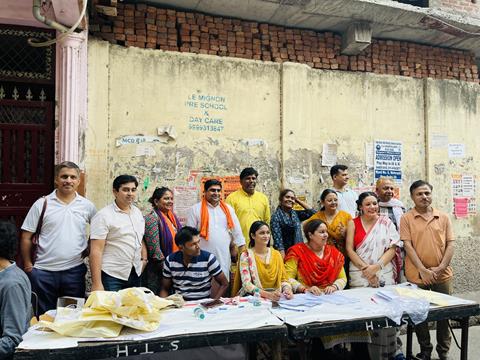Phase 6 of General Elections 2024: High Turnout Marks Crucial Milestone
Sonia Gandhi, Rahul Gandhi, and Priyanka Gandhi Vadra voted in New Delhi, but due to a seat-sharing arrangement with AAP, they couldn't vote for a Congress candidate, highlighting a rare, demoralizing scenario for the party.
The sixth phase of the 2024 General Elections marked a significant milestone in India’s democratic process. Polling took place across 58 Parliamentary Constituencies (PCs) in eight states and Union Territories (UTs). At 7:45 PM, the overall voter turnout was 59.06%, showcasing robust participation despite challenging weather conditions in several regions.
process. Polling took place across 58 Parliamentary Constituencies (PCs) in eight states and Union Territories (UTs). At 7:45 PM, the overall voter turnout was 59.06%, showcasing robust participation despite challenging weather conditions in several regions.
One of the standout performances in this phase was seen in the Anantnag-Rajouri constituency in Jammu and Kashmir, which reported a turnout of 52.28% by 7:45 PM. This is a remarkable figure, being the highest in many decades, reflecting a resurgence of electoral engagement in the region. The peaceful polling in this constituency and an impressive turnout highlight a positive trend in the political climate of Jammu and Kashmir.
In Delhi, the national capital, the voter turnout was approximately 54.48% until 7 PM across its seven Lok Sabha constituencies. North East Delhi had the highest turnout at 57.97%, while New Delhi had the lowest at 50.44%. This turnout is slightly lower than the 60.52% recorded in the 2019 general elections when the Bharatiya Janata Party (BJP) secured all seven seats. The voter turnout in various constituencies of Delhi till 5 PM included Chandni Chowk (53.27%), East Delhi (53.69%), North West Delhi (53.17%), West Delhi (54.15%), and South Delhi (51.84%).
The presence of senior Congress leaders Sonia Gandhi, Rahul Gandhi, and Priyanka Gandhi Vadra at polling stations in New Delhi was a notable event. However, due to the seat-sharing arrangement between the Congress and the Aam Aadmi Party (AAP), they could not vote for a Congress candidate in the New Delhi constituency, marking a rare and potentially demoralizing situation for the party’s stalwarts.
Overall, the sixth phase of polling recorded a voter turnout of 59.06% by 7:45 PM. This phase was crucial as it completed polling in 486 of the 543 Lok Sabha seats and concluded elections in Haryana, Delhi, Jammu and Kashmir. Despite the hot weather in parts of the country, voter enthusiasm remained undeterred, with long queues observed at various polling stations.
The polling in Jammu and Kashmir concluded with significant turnouts in all three PCs: Srinagar (38.49%), Baramulla (59.1%), and Anantnag-Rajouri (52.28%). These figures are noteworthy, considering the region’s historically low voter participation due to political unrest and security concerns.
In this phase, elections were conducted in Bihar, Haryana, Jharkhand, Delhi, Odisha, Uttar Pradesh, West Bengal, and Jammu and Kashmir. A total of 889 candidates contested across these constituencies. The Election Commission of India (ECI) ensured smooth and peaceful polling through stringent security measures, creating a conducive environment for voters.
 The voter turnout figures, updated live on the ECI’s Voter Turnout App, will continue to be revised until the final numbers are confirmed. As per the procedure, election papers will be scrutinized the day after polling in the presence of candidates or their authorized agents. Decisions on any potential repolling will also be made during this scrutiny.
The voter turnout figures, updated live on the ECI’s Voter Turnout App, will continue to be revised until the final numbers are confirmed. As per the procedure, election papers will be scrutinized the day after polling in the presence of candidates or their authorized agents. Decisions on any potential repolling will also be made during this scrutiny.
Odisha witnessed simultaneous polling for 42 Assembly Constituencies and its Parliamentary Constituencies, recording a voter turnout of 60.07% by 7:45 PM. The state’s polling stations witnessed jubilation as voters, including those from Particularly Vulnerable Tribal Groups (PVTGs), proudly displayed their inked fingers.
With the conclusion of phase six, polling for the General Elections 2024 is now complete in 28 states/UTs and 486 PCs. This phase also saw the completion of elections for the State Legislative Assemblies of Arunachal Pradesh, Sikkim, Andhra Pradesh, and 105 Assembly seats in Odisha.
The final phase of polling, scheduled for June 1, 2024, will cover 57 PCs across eight states/UTs. As the nation approaches the culmination of this extensive electoral exercise, the focus now shifts to the remaining constituencies and the subsequent counting of votes, which will ultimately shape India’s political landscape for the next five years.
(Inputs from PIB press release)
